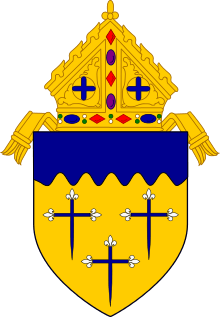Roman Catholic Diocese of Superior
| Diocese of Superior Dioecesis Superiorensis | |
|---|---|
 | |
| Location | |
| Country | United States |
| Territory | 16 counties in northwestern Wisconsin |
| Ecclesiastical province | Milwaukee |
| Statistics | |
| Area | 15,715 sq mi (40,700 km2) |
| Population - Total - Catholics |
(as of 2010) 458,000 78,826 (17.2%) |
| Parishes | 105 |
| Information | |
| Denomination | Roman Catholic |
| Rite | Roman Rite |
| Established | May 3, 1905 (109 years ago) |
| Cathedral | Cathedral of Christ the King |
| Patron saint | St. Augustine of Hippo |
| Current leadership | |
| Pope | Francis |
| Bishop | Vacant |
| Map | |
_map_1.jpg) | |
| Website | |
| www.catholicdos.org | |
The Roman Catholic Diocese of Superior (Latin: Dioecesis Superiorensis) encompasses the city of Superior and the counties of Ashland, Barron, Bayfield, Burnett, Douglas, Iron, Lincoln, Oneida, Price, Polk, Rusk, Sawyer, St. Croix, Taylor, Vilas, and Washburn in northern Wisconsin, with an area of 15,715 square miles (40,700 km2). Its episcopal see is Superior, and the Cathedral of Christ the King in Superior is its mother church. It is a suffragan diocese of the Archdiocese of Milwaukee.
History
The diocese was established on May 3, 1905 by Pope Pius X.[1] It was created from the northern part of the Diocese of La Crosse and the northwestern part of the Diocese of Green Bay, with Augustine Francis Schinner as the first bishop.[2][3]
Bishops
The following is a list of the Roman Catholic Bishops of the Diocese of Superior and their years of service:
- †Augustine Francis Schinner (1905–1913)
- †Joseph Maria Koudelka (1913–1921)
- †Joseph G. Pinten (1922–1926)
- †Theodore H. Reverman (1926–1941)
- †William Patrick O'Connor (1942–1946)
- †Albert Gregory Meyer (1946–1953)
- †Joseph John Annabring (1954–1959)
- †George Albert Hammes (1960–1985)
- Raphael Michael Fliss (1985–2007)
- Peter F. Christensen (2007–2014)
- (To be announced, November 4, 2014)
Publications
The Diocese of Superior publishes a bi-weekly newspaper, The Superior Catholic Herald, which was established in 1953. There are approximately 12,000 subscribers and an estimated readership of more than 36,000 given the pass-along rate, each issue.[4]
See also
| Wikisource has the text of the 1913 Catholic Encyclopedia article Diocese of Superior. |
- List of the Catholic dioceses of the United States
- List of Roman Catholic dioceses (alphabetical)
- List of Roman Catholic dioceses (structured view)
References
- ↑ Blied, Rev. Benjamin J. (1980). St. John the Baptist Congregation. p. 62.
- ↑ "Diocese of Superior". Catholic-Hierarchy. Retrieved 2014-04-16.
- ↑ "Diocese of Superior". Gcatholic.org. Retrieved 2014-04-16.
- ↑ Superior Catholic Herald, About Us
External links
| Wikimedia Commons has media related to Roman Catholic Diocese of Superior. |
- Diocese of Superior
- History of the Catholic Diocese of Superior, Wisconsin
- Christ the King Cathedral
- Superior Catholic Herald newspaper
Arms
 |
The crosses further commemorate the edict of King Charles V in 1376, when he reduced the number of fleur-de-lis in the French coat-of-arms to three in honor of the Three Divine Persons. The blue waters of Lake Superior are indicated across the top of the shield by the wavy blue lines of the "chief" or upper partition. |
| |||||||||||||||||||||
| ||||||
Coordinates: 46°42′25″N 92°05′07″W / 46.70694°N 92.08528°W